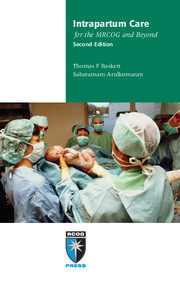Book contents
- Frontmatter
- Contents
- Preface
- Abbreviations
- 1 Improving intrapartum care
- 2 First stage of labour
- 3 Second stage of labour
- 4 Fetal surveillance in labour
- 5 Third stage of labour
- 6 Lower genital tract trauma
- 7 Induction of labour
- 8 Preterm labour and prelabour rupture of membranes
- 9 Assisted vaginal delivery
- 10 Shoulder dystocia
- 11 Breech vaginal delivery
- 12 Twin and triplet delivery
- 13 Caesarean section
- 14 Vaginal birth after caesarean section
- 15 Uterine rupture
- 16 Emergency obstetric hysterectomy
- 17 Cord prolapse
- 18 Antepartum haemorrhage
- 19 Postpartum haemorrhage
- 20 Acute uterine inversion
- 21 Amniotic fluid embolism
- 22 Disseminated intravascular coagulation
- 23 Acute tocolysis
- 24 Severe pre-eclampsia and eclampsia
- 25 Neonatal resuscitation
- 26 Perinatal loss: management of late fetal death and stillbirth
- Index
18 - Antepartum haemorrhage
Published online by Cambridge University Press: 05 July 2014
- Frontmatter
- Contents
- Preface
- Abbreviations
- 1 Improving intrapartum care
- 2 First stage of labour
- 3 Second stage of labour
- 4 Fetal surveillance in labour
- 5 Third stage of labour
- 6 Lower genital tract trauma
- 7 Induction of labour
- 8 Preterm labour and prelabour rupture of membranes
- 9 Assisted vaginal delivery
- 10 Shoulder dystocia
- 11 Breech vaginal delivery
- 12 Twin and triplet delivery
- 13 Caesarean section
- 14 Vaginal birth after caesarean section
- 15 Uterine rupture
- 16 Emergency obstetric hysterectomy
- 17 Cord prolapse
- 18 Antepartum haemorrhage
- 19 Postpartum haemorrhage
- 20 Acute uterine inversion
- 21 Amniotic fluid embolism
- 22 Disseminated intravascular coagulation
- 23 Acute tocolysis
- 24 Severe pre-eclampsia and eclampsia
- 25 Neonatal resuscitation
- 26 Perinatal loss: management of late fetal death and stillbirth
- Index
Summary
Antepartum haemorrhage is bleeding from the genital tract from 20 weeks of gestation until delivery of the baby. This definition may vary from 20 to 24 weeks of gestation in different countries, in keeping with local medical and legal definitions of fetal viability.
The main causes of antepartum haemorrhage are placenta praevia (1/200–300), placental abruption (1/100) and unclassified (1/100) maternities. In addition, a number of women present with antepartum bleeding from lower genital tract lesions such as vulvovaginal varices, cervical polyps and cervical cancer. While it is important to diagnose and treat such lesions, they will not, as a group, be considered further in this chapter.
Placenta praevia
In placenta praevia, the placenta is implanted in part or in whole on the lower uterine segment, which is that portion of the uterus beneath the reflection of the uterovesical peritoneum. Functionally, it is that part of the myometrium that develops in the latter half of pregnancy, is stretched and thinned during late pregnancy and is relatively passive and non-contractile. When fully developed in labour, it may extend 7–8 cm from the internal os: about the length of the examining finger.
The incidence of placenta praevia is increased with higher parity, advancing maternal age and in those previously delivered by caesarean section; the latter two factors are seen in increasing number in the obstetric population. The overall recurrence risk of placenta praevia is about 1/20.
- Type
- Chapter
- Information
- Intrapartum Care for the MRCOG and Beyond , pp. 195 - 210Publisher: Cambridge University PressPrint publication year: 2011



